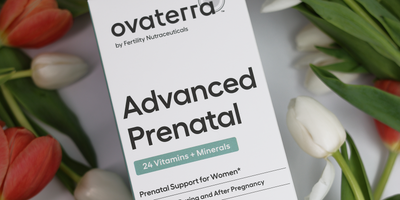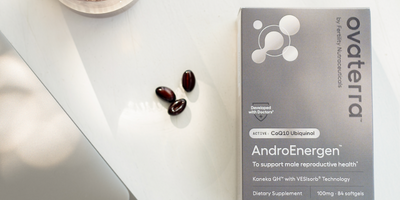A plant-derived antioxidant, Vitamin E has been an active topic of research in reproductive health arena. While the mechanism of action and the optimal method of supplementation are still being investigated, scientists have suggested that Vitamin E may support multiple aspects of female reproductive health, as well as prenatal and neonatal health. In fact, before it was identified, scientists referred to Vitamin E as "anti-sterility factor X."
Let's take a look at a recent review that summarizes the state of the Vitamin E research as it relates to reproductive health and pregnancy.
Key findings
- In animal studies, Vitamin E supplementation was suggested to counter the negative effects of nicotine, a known inducer of oxidative stress. In one study, rats that were given vitamin E were more than 2.5 times as likely to have a pregnancy than those that were not (83% vs. 33%).
- In multiple animal models, embryos cultured in a medium containing Vitamin E were more likely to develop into the blastocyst stage. They were developmentally ahead of the non-treated embryos, even days after transfer. Some studies also suggested that the addition of Vitamin E in the culture medium may reduce DNA fragmentation.
- Vitamin E has been suggested to slow apoptosis of the ovarian cells from oxidative stress induced by a chemotherapy drug called cyclophosphamide.
- Women with a history of multiple miscarriages were found to have lower levels of serum Vitamin E, along with higher lipid peroxidation (degradation of lipids) levels.
Vitamin E, oxidative stress and reproductive health
Vitamin E is a group of 8 chemical compounds called tocopherols (TOCs) and tocotrienols (TCTs). Only one form, the alpha-tocopherol, is used by the human body.
Interestingly, Vitamin E has been closely associated with reproductive health since it was first described by Evans and Bishop in 1922: They described in the journal Science an “anti-sterility factor X” that, in addition to the already known vitamin B and C, was necessary in normal reproduction. This mysterious “factor X” was isolated from wheat germ, and named Vitamin E in 1936.
In the last three decades, numerous studies have suggested that vitamin E can function as an antioxidant, protecting various biological functions and organs – including reproductive functions and organs - from oxidative stress.
Vitamin E appears to scavenge reactive oxygen species (ROS, a type of unstable, reactive molecule that damages DNA and other components of cells), possibly preventing ROS from causing damage and cell death. A randomized, double-blinded controlled trial found that pregnant women who were antioxidant-deficient had significantly better maternal and perinatal outcomes when supplementing with a mix of antioxidants, including 400 IU of Vitamin E than those who received a placebo.
Healthy levels of Vitamin E have also been associated with healthy pregnancy and favorable outcomes, including normal blood pressure during pregnancy, age-appropriate fetal growth and full-term pregnancy.
Vitamin E and baby's brain health
Vitamin E also appears to prevent ROS-induced deterioration of other compounds that support reproductive health, such as polyunsaturated fatty acids. Since one of the polyunsaturated fatty acids is omega-3/DHA, which supports the baby’s brain development, sufficient intake of Vitamin E before and during pregnancy may be important for the healthy neural development of the baby.
Vitamin E and your reproductive health
Given the potential role of Vitamin E in reproductive, prenatal and neonatal health, it's a good idea to make sure you are getting enough Vitamin E each day during the preconception period and throughout pregnancy.
- Aim fo 15 mg. National Institutes of Health recommends 15 mg (22 IU) of alpha-tocopherol for adult women, as well as pregnant women. When nursing, 19 mg (28 IU) is recommended.
-
Eat nuts, seeds and vegetables. Because a wide variety of foods contain Vitamin E, deficiency is rare in the developed world, but it’s a good idea to make sure your diet contains enough of this antioxidant. Synthesized naturally by plants, Vitamin E is abundant in plant-based oils, nuts, seeds and green, leafy vegetables. Foods high in Vitamin E include:
- Sunflower seeds: 7.4 mg in 1 oz
- Almonds: 6.8 mg in 1 oz
- Safflower oil: 4.6 mg in 1 tablespoon
- Peanut butter: 1.5 mg in 1 tablespoon
- Spinach (boiled): 1.9 mg in ½ cup
- Broccoli (boiled): 1.2 mg in ½ cup
- Eat it with healthy fat. Because Vitamin E is a fat-soluble compound, eating vitamin E-rich foods with healthy fat increases its absorption. Nuts are fantastic, as they naturally come with healthy fat. Spinach or broccoli sautéed in olive oil is another easy way to deliver this antioxidant to your system.
- Take it with Vitamin C. Vitamin E and Vitamin C are known to work synergistically in protecting cells from oxidative stress. Many fruits and leafy vegetables, such as berries, avocado, tomato, spinach and broccoli are a good source of both Vitamins E and C.
- Know if you are at risk. People with digestive disorders or who have difficulty absorbing fats may be deficient in Vitamin E. This includes people with cystic fibrosis, celiac disease and pancreatitis. Talk to your doctor if you are at higher risk of Vitamin E deficiency.
Whether pre-conception and pregnant women should take Vitamin E supplements is still being debated. As always, we recommend discussing your supplementation with your healthcare team – after all, they are the one who knows you best and can tailor supplements and treatments to your unique needs.
If you or your team have any questions, please reach out. We are with you.
Study vitals
- Title: Vitamin E as an Antioxidant in Female Reproductive Health
- Authors: Siti Syairah Mohd Mutalip, Sharaniza Ab-Rahim and Mohd Hamim Rajikin
- Publication date: January 26, 2018
- Journal: Antioxidants
- Study type: Review












